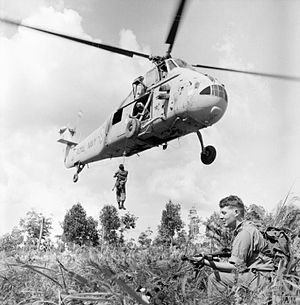利用者:Well Pled
| ||||||||||||||||||||||||||||||
| Template:Campaignbox Indonesia–Malaysia confrontation | ||||||||||||||||||||||||||||||
インドネシアとマレーシアの対立またはボルネオの対立(インドネシア語/マレー語の名前であるとも呼ばれる)は、1963 年から1966 年ま konfrontasi での武力紛争であり、インドネシアがマレーシア連邦の創設に反対したことに端を発しています。 1966 年にインドネシア大統領スカルノが解任された後、紛争は平和的に終結し、マレーシア国家が形成されました。
The creation of Malaysia was a merger of the Federation of Malaya (now Peninsular Malaysia), Singapore and the British crown colonies of North Borneo and Sarawak (collectively known as British Borneo, now East Malaysia) in September 1963.[24] Vital precursors to the conflict included Indonesia's policy of confrontation against Netherlands New Guinea from March–August 1962 and the Brunei Revolt in December 1962. Malaysia had direct military support from Great Britain, Australia and New Zealand. Indonesia had indirect support from the USSR and China, thus making it an episode of the Cold War in Asia.
The conflict was an undeclared war with most of the action occurring in the border area between Indonesia and East Malaysia on the island of Borneo (known as Kalimantan in Indonesia). The conflict was characterised by restrained and isolated ground combat, set within tactics of low-level brinkmanship. Combat was usually conducted by company- or platoon-sized operations on either side of the border. Indonesia's campaign of infiltrations into Borneo sought to exploit the ethnic and religious diversity in Sabah and Sarawak compared to that of Malaya and Singapore, with the intent of unravelling the proposed state of Malaysia.
The jungle terrain of Borneo and lack of roads straddling the Malaysia–Indonesia border forced both Indonesian and Commonwealth forces to conduct long foot patrols. Both sides relied on light infantry operations and air transport, although Commonwealth forces enjoyed the advantage of better helicopter deployment and resupply to forward operating bases. Rivers were also used as a method of transport and infiltration. Although combat operations were primarily conducted by ground forces, airborne forces played a vital support role and naval forces ensured the security of the sea flanks. The British provided most of the defensive effort, although Malaysian forces steadily increased their contributions, and there were periodic contributions from Australian and New Zealand forces within the combined Far East Strategic Reserve stationed then in West Malaysia and Singapore.[25]
Initial Indonesian attacks into East Malaysia relied heavily on local volunteers trained by the Indonesian Army. Over time, infiltration forces became more organised with the inclusion of a more substantial component of Indonesian forces. To deter and disrupt Indonesia's growing campaign of infiltrations, the British responded in 1964 by launching their own covert operations into Indonesian Kalimantan under the code name Operation Claret. Coinciding with Sukarno announcing a 'year of dangerous living' and the 1964 race riots in Singapore, Indonesia launched an expanded campaign of operations into West Malaysia on 17 August 1964, albeit without military success.[26] A build-up of Indonesian forces on the Kalimantan border in December 1964 saw the UK commit significant forces from the UK-based Army Strategic Command and Australia and New Zealand deployed roulement combat forces from West Malaysia to Borneo in 1965–66. The intensity of the conflict began to subside following the coup d'etat of October 1965 and Sukarno's loss of power to General Suharto. A serious peace negotiations between Indonesia and Malaysia began on May 1966, and a final peace agreement was signed on 11 August 1966 with Indonesia formally recognising Malaysia.[18]
- ^ “Commonwealth Backing for Malaysia”. The Sydney Morning Herald: pp. 2. (1964年11月24日). オリジナルの2015年11月19日時点におけるアーカイブ。 2015年2月19日閲覧。
- ^ Robert Bothwell; Jean Daudelin (17 March 2009). Canada Among Nations, 2008: 100 Years of Canadian Foreign Policy. McGill-Queen's Press – MQUP. pp. 284–. ISBN 978-0-7735-7588-2. オリジナルの15 February 2017時点におけるアーカイブ。 2017年1月26日閲覧。
- ^ “Malaysian–American Relations during Indonesia's Confrontation against Malaysia, 1963–66”. Cambridge University Press (2009年8月24日). Template:Cite webの呼び出しエラー:引数 accessdate は必須です。
- ^ Conboy 2003, pp. 93–95.
- ^ Conboy 2003, p. 156.
- ^ Fowler 2006, pp. 11, 41
- ^ Pocock 1973, p. 129.
- ^ Corbett 1986, p. 124.
- ^ a b Hara, Fujiol (December 2005). “The North Kalimantan Communist Party and the People's Republic of China”. The Developing Economies XLIII (1): 489–513. doi:10.1111/j.1746-1049.2005.tb00956.x. hdl:10.1111/j.1746-1049.2005.tb00956.x.
- ^ Sejarah Indonesia : "The Sukarno Years". Retrieved 30 May 2006.
- ^ A. Dahana (2002年). “China Role's in Indonesia's "Crush Malaysia" Campaign”. Universitas Indonesia. 2016年7月19日時点のオリジナルよりアーカイブ。2016年7月19日閲覧。
- ^ John W. Garver (1 December 2015). China's Quest: The History of the Foreign Relations of the People's Republic of China. Oxford University Press. pp. 219–. ISBN 978-0-19-026106-1
- ^ Hamilton Fish Armstrong (1963年7月). “The Troubled Birth of Malaysia”. Foreign Affairs. Template:Cite webの呼び出しエラー:引数 accessdate は必須です。
- ^ Kurt London (1974). The Soviet Impact on World Politics. Ardent Media. pp. 153–. ISBN 978-0-8015-6978-4
- ^ Mohd. Noor Mat Yazid (2013年). “Malaysia-Indonesia Relations Before and After 1965: Impact on Bilateral and Regional Stability”. Programme of International Relations, School of Social Sciences, Universiti Malaysia Sabah. 2016年7月19日時点のオリジナルよりアーカイブ。2016年7月19日閲覧。
- ^ Jones 2002, pp. 132, 146, 163.
- ^ Andretta Schellinger (12 February 2016). Aircraft Nose Art: American, French and British Imagery and Its Influences from World War I through the Vietnam War. McFarland. pp. 152–. ISBN 978-0-7864-9771-3. オリジナルの15 February 2017時点におけるアーカイブ。 2017年1月26日閲覧。
- ^ a b Dennis & Grey 1996, p. 318.
- ^ UK Armed Forces Operational deaths post World War II. Ministry of Defence. (2015). p. 4
- ^ “Indonesian Confrontation, 1963–66 | Australian War Memorial”. www.awm.gov.au. Template:Cite webの呼び出しエラー:引数 accessdate は必須です。
- ^ “NZ and Confrontation in Borneo – Confrontation in Borneo | NZHistory, New Zealand history online”. nzhistory.govt.nz. Template:Cite webの呼び出しエラー:引数 accessdate は必須です。
- ^ “SPEECH BY THE PRESIDENT OF THE SAF VETERANS’ LEAGUE, BRIGADIER-GENERAL (NS) WINSTON TOH, AT THE KONFRONTASI MEMORIAL CEREMONY ON 10 MARCH 2016, 1825HRS |”. Template:Cite webの呼び出しエラー:引数 accessdate は必須です。
- ^ Peter Paret; Gordon A. Craig; Felix Gilbert (30 October 1986). Makers of Modern Strategy from Machiavelli to the Nuclear Age. OUP Oxford. ISBN 978-0-19-820097-0
- ^ Mackie 1974, pp. 36–37 & 174.
- ^ Dennis & Grey 1996, p. 25.
- ^ Edwards 1992, p. 306.
引用エラー: 「注釈」という名前のグループの <ref> タグがありますが、対応する <references group="注釈"/> タグが見つかりません

